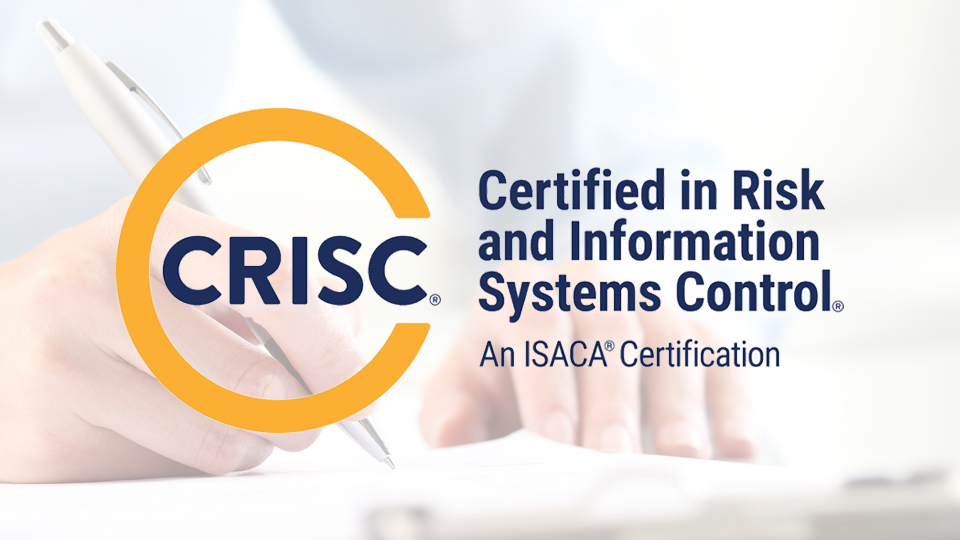
“The price of doing the same old thing is far higher than the price of change.” Bill Clinton’s observation succinctly captures the rationale behind preparing your team for CRISC certification. As cyber threats proliferate globally, Saudi Arabian government entities, ministries, and universities urgently need skilled professionals to manage IT and cybersecurity risks. The CRISC certification from ISACA validates expertise in IT risk identification, assessment, and evaluation. Providing a CRISC course for your IT, cybersecurity, and GRC staff demonstrates your commitment to strengthening risk management. Partnering with an accredited training center like ES Learning ensures your team receives top-notch CRISC exam preparation. Invest now in qualified risk management professionals – the cost of inaction is simply too high.
Develop expertise in IT risk management

The CRISC certification focuses on four key domains: Risk Identification, Assessment, and Evaluation; Risk Response; Risk Monitoring; and Information Systems Control Design and Implementation. Earning the CRISC validates an individual’s ability to identify and manage risks across an enterprise. With cyber threats on the rise, entities need professionals with proven risk management expertise.
Stay ahead of industry changes
Technology and risks evolve rapidly. Ongoing learning is key to navigating changes and protecting critical assets. The CRISC requires candidates to have at least three years of relevant work experience and pass an exam assessing knowledge of the latest risk management practices. Maintaining the certification also demands annual continuing education to ensure credentials remain up-to-date.
Gain a competitive advantage

In a global economy, a skilled and certified workforce provides a key competitive advantage. The CRISC is an internationally recognized standard of excellence in IT risk management. By investing in employee CRISC certification, organizations can attract and retain top talent, work more efficiently, and build credibility with stakeholders.
Professional certifications confer benefits at both the individual and organizational levels. For IT risk professionals in Saudi Arabia, the CRISC offers a way to gain valuable knowledge, strengthen expertise, and advance their careers. For government entities and companies, supporting employee CRISC certification leads to a more capable, innovative, and resilient workforce. An investment in knowledge pays substantial dividends.
Overview of the CRISC Certification
To adequately prepare one’s team for the Certified in Risk and Information Systems Control (CRISC) exam, it is important to understand what the certification entails. The CRISC certification, offered by ISACA, is designed for professionals with at least three years of relevant experience in IT risk management.
Candidates for the CRISC certification should have expertise in the four core areas covered by the exam: risk identification, risk assessment, risk response, and risk monitoring. They fill roles such as IT risk analyst, compliance officer, and risk management director. The CRISC certification validates their ability to identify and evaluate IT risks, implement appropriate risk management strategies, monitor risk across the organization, and ensure compliance with laws and regulations.
Exam Content

The CRISC exam covers four domains: risk identification (27%), risk assessment (28%), risk response (23%), and risk monitoring (22%). Candidates must demonstrate knowledge of how to identify, analyze, and evaluate IT risks. They must understand various risk assessment models and be able to perform risk assessments. They need to know how to develop risk responses, evaluate response options, and determine appropriate responses. Finally, candidates must comprehend how to implement risk monitoring techniques and oversee a risk management program.
Preparation
To prepare a team for the CRISC exam, training in risk management frameworks, standards, and processes is essential. Both conceptual knowledge and hands-on experience with risk assessment tools are important. Team members should study the CRISC Review Manual and take practice questions to become familiar with the format and content of the exam. With diligent preparation focused on the four exam domains, team members will gain the knowledge and confidence to become CRISC certified. Achieving this certification will validate their competence in IT risk management and allow them to better protect their organization’s information assets.
Key Benefits of CRISC Certification for Your Team

Strengthens Knowledge of Risk Management
The CRISC certification provides professionals with a comprehensive understanding of risk management based on industry standards and best practices. To earn CRISC certification, candidates must demonstrate knowledge across four domains: risk identification, assessment, response, and monitoring. Achieving CRISC certification signifies that professionals have a strong grasp of risk management concepts and are equipped to apply them in an enterprise setting.
Prepares for Career Advancement
CRISC certification sets professionals up for career growth by validating their skills and expertise in IT risk management. Studies show that IT certifications can lead to higher salaries and more opportunities for career progression. For organizations, CRISC-certified employees are better positioned to take on more senior risk management roles as they gain additional experience. Promoting from within also helps retain top talent.
Improves Risk Management Capabilities
With CRISC-certified professionals on staff, organizations can enhance their risk management programs and address key risk areas. Certified risk managers utilize industry standards and best practices to systematically identify, analyze, and mitigate risks. They provide a disciplined approach to risk management that yields both short and long-term benefits. Organizations that invest in risk management certification for their teams gain a competitive advantage through stronger risk oversight and governance.
CRISC certification for IT risk management professionals provides significant benefits for both individuals and organizations. For professionals, it strengthens knowledge, opens up career opportunities and the potential for higher pay. For organizations, it improves risk management capabilities, ensures compliance with standards, and develops talent from within. Providing CRISC certification training for teams will prepare them to better manage risks in today’s complex IT environments. Overall, CRISC certification leads to a stronger, better-equipped risk management function.
The CRISC Exam: What to Expect

To obtain the CRISC certification, candidates must pass the CRISC exam. This rigorous exam assesses a candidate’s knowledge and skills in the four domains that comprise the CRISC Common Body of Knowledge (CBOK): Risk Identification, Assessment and Evaluation; Risk Response; Risk Monitoring; and Information Systems Control Design and Implementation.
The CRISC exam is a computer-based exam consisting of 150 multiple-choice questions. Candidates have 4 hours to complete the exam. To pass the exam, candidates must achieve a score of at least 500 on a scale of 200 to 800. The questions on the exam are scenario-based to test candidates’ ability to apply their knowledge in real-world situations.
Adequate preparation for the CRISC exam is essential. Candidates should have at least 3 years of work experience in IT risk management and information systems control. They should also study the CRISC Review Manual to gain a thorough understanding of the concepts and topics in the CBOK. Taking a CRISC training course can also be helpful to reinforce and expand one’s knowledge. Some training providers offer boot camps, online courses, and instructor-led courses.
Practicing with CRISC exam questions is another key part of preparation. ISACA provides sample questions and practice exams on their website. Candidates can also find many additional practice questions and mock exams from other training providers and websites. Repeated practice helps familiarize candidates with the format and content of the actual exam questions.
With diligent preparation and persistence, government organizations can empower their employees to achieve CRISC certification. By supporting candidates through training and exam fees, organizations enable their IT risk and cybersecurity professionals to gain this prestigious credential. In turn, organizations benefit from a more skilled, competent, and valuable workforce. Overall, the CRISC certification program is a worthwhile investment that pays long-term dividends for both individuals and organizations.
CRISC Certification Requirements and Prerequisites
To become a Certified in Risk and Information Systems Control (CRISC), candidates must meet certain requirements and prerequisites. As an accredited CRISC training center, ES Learning ensures that potential candidates are well-prepared to meet ISACA’s eligibility criteria and pass the CRISC exam.
Minimum 3 Years of IT Risk Management Experience
Candidates are required to have a minimum of three years of IT risk management experience, which must be verified when candidates apply to take the CRISC exam. Experience may include evaluating IT systems and controls, overseeing risk assessments, managing IT audits, developing organizational risk frameworks, and monitoring risk to determine if it falls within tolerance levels.
Successful Completion of the CRISC Examination
After meeting the experience requirement, candidates must pass the CRISC exam. The exam covers four domains: Risk Identification, Assessment, and Evaluation; Risk Response; Risk Monitoring; and Information Systems Control Design and Implementation. Candidates have four hours to complete the 150 multiple-choice questions. A passing score is 450 out of 800 points or 56 percent.
Code of Professional Ethics
All CRISC certification holders must adhere to ISACA’s Code of Professional Ethics. The code sets standards for competent and ethical professional risk, control, and governance practices. It covers integrity, objectivity, confidentiality, and competence. By upholding these ethical standards, CRISC professionals inspire trust and confidence in their work.
To summarize, the key requirements to become a CRISC are verifiable IT risk management experience, passing the CRISC exam, and committing to ISACA’s ethical standards. ES Learning provides the necessary training and preparation for candidates to meet these prerequisites and join the growing global community of CRISC professionals.
Developing an Effective CRISC Training Program
A robust training program is essential for preparing team members for CRISC certification. According to industry experts, the key to developing an effective program is focusing on the four core domains of the certification: risk identification, risk assessment, risk response, and risk monitoring.
Risk Identification
The first domain involves identifying and recognizing risks that could impact an organization’s IT systems and infrastructure. An effective training program should teach participants how to pinpoint risks through activities like risk workshops, risk surveys, and risk reviews of systems and software. Participants should become adept at spotting a comprehensive range of risks, from compliance issues to system vulnerabilities.
Risk Assessment
Once risks have been identified, they must be analyzed to determine their potential impact. The risk assessment domain focuses on evaluating risks based on factors like likelihood of occurrence and severity of impact. A high-quality CRISC training program will equip participants with skills for assessing risks quantitatively and qualitatively based on established risk assessment methodologies. Participants should learn risk rating scales and risk assessment techniques that align with industry standards.
Risk Response
The risk response domain involves determining appropriate responses to risks and developing risk mitigation plans. An effective CRISC training program should provide instruction in selecting risk responses that are cost-effective and match an organization’s risk appetite. Participants should learn response strategies like avoidance, transference, acceptance, and mitigation. They should also learn how to create detailed risk mitigation plans, including risk owners, timelines, budgets, and metrics for success.
Risk Monitoring
The final domain, risk monitoring, focuses on overseeing risk responses and mitigation plans to ensure their effectiveness. A comprehensive CRISC training program should teach participants how to design and implement risk monitoring procedures, including identifying risk metrics and key performance indicators. Participants should learn how to monitor risk metrics, re-assess risks, and make adjustments to risk responses as needed to optimize risk management programs.
By focusing on these four domains through a combination of training techniques, organizations can develop programs to adequately prepare candidates for CRISC certification. With diligent preparation, participants can gain the knowledge and skills to pass the exam and contribute as proficient risk management professionals.
CRISC Certification Cost and Return on Investment
The certification and maintenance fees for the CRISC certification provide good value. According to ISACA, the CRISC certification exam costs $575 for ISACA members and $760 for non-members. There is also an application processing fee of $50. While these fees may seem high, obtaining the CRISC certification can provide professionals with a strong return on investment (ROI).
Increased Compensation
With a CRISC certification, professionals can qualify for higher pay. According to PayScale, the average salary for a Certified in Risk and Information Systems Control (CRISC) in Saudi Arabia is SAR 202,857. Professionals with a CRISC certification tend to earn 10-15% higher pay than their non-certified counterparts. The increased compensation can offset the cost of certification and provide a good ROI over the span of a career.
Improved Job Prospects
The CRISC certification can open up more career opportunities. It signifies that the professional has a strong understanding of IT risk management and the ability to implement enterprise risk management. This can make the professional a strong candidate for leadership roles like IT Risk Manager, Cyber Risk Manager or Chief Risk Officer. A CRISC certification may even help professionals land a new job or get promoted to a higher position with more responsibilities.
Demonstrated Commitment to the Field
By obtaining the CRISC certification, professionals demonstrate a commitment to IT risk management excellence and continuous learning. This signals to employers that the professional is dedicated to keeping their knowledge and skills up to date with the latest standards and best practices. Such commitment and expertise are appealing qualities that can set the professional apart.
In summary, while the CRISC certification does come at a cost, the potential benefits to one’s career and compensation can provide professionals a sizable return on their investment in the long run. For government entities and organizations, sponsoring employees in obtaining the CRISC certification can be a strategic move to boost IT risk management capabilities and gain a competitive edge. The rewards to both individuals and organizations make the CRISC certification worth the investment.
Preparing for CRISC Certification Success
To prepare team members for the Certified in Risk and Information Systems Control (CRISC) exam, management should implement a comprehensive study plan. According to ISACA, the organization that administers the CRISC, candidates should study for a minimum of one to two hours per day over two months to prepare adequately. Enrolling team members in a formal certification preparation course, whether online or in-person, is highly recommended to supplement individual study.
A guided course provides instruction on the four knowledge domains tested in the CRISC exam: risk identification, risk assessment, risk response, and risk monitoring. Coursework explores risk management concepts and processes in depth, reinforcing key terms and methodologies. Instructors can also provide valuable advice for exam-taking strategies and share updated information on current issues in IT risk management.
In addition to a certification course, management should provide team members with access to the latest official preparation materials from ISACA, including the CRISC Review Manual and practice questions. The review manual covers all topics in the CRISC exam, while practice questions help build familiarity with the format and experience of the actual certification test.
A final critical step is ensuring candidates schedule adequate time to study and practice. Two months of consistent preparation with in-depth review of all materials is typically the minimum required. However, more time may be needed for candidates with less experience in IT risk management. Management should work with team members to develop a customized study plan based on their current knowledge and skills.
With the proper preparation and resources, team members can gain the knowledge and confidence to pass the CRISC exam. Achieving this respected certification demonstrates a commitment to excellence in IT risk management and will benefit both individuals and the organization as a whole. Providing support for certification success is an investment that yields significant rewards.
CRISC Exam Cost FAQs
The Certified in Risk and Information Systems Control (CRISC) certification exam is designed to evaluate a candidate’s knowledge and skills in IT risk management. To earn the CRISC certification, candidates must pass a rigorous exam developed by the Information Systems Audit and Control Association (ISACA). The CRISC exam consists of 150 multiple-choice questions that must be completed within 3 hours.
The exam fees for the CRISC certification range from $575 to $965 USD depending on a candidate’s ISACA membership status. ISACA members receive a discount on exam fees compared to non-members. Additional fees may apply for study materials, training courses, and re-taking the exam. The CRISC exam fees are non-refundable and non-transferable. A $50 processing fee will be applied for exam registration.
To prepare for the CRISC exam, candidates will need to commit many hours to studying the exam’s official content outline and reference materials. While training and preparation courses are optional, many candidates find them helpful for gaining an understanding of the core concepts and knowledge areas covered on the exam. ES Learning, an accredited training center in Riyadh, offers a CRISC certification course to help candidates prepare for the exam. Their course covers all domains in the CRISC exam, and students receive access to official ISACA study materials as well as guidance from an experienced instructor.
The CRISC certification provides objective proof of a candidate’s competence and expertise in IT risk management. Earning this credential can open up career opportunities and lead to higher pay. The Saudi Arabian government, ministries and universities would benefit greatly from sponsoring their IT, cybersecurity and governance risk and compliance professionals to pursue the CRISC certification. Doing so will strengthen their organizations’ risk management practices and better secure critical information assets. Overall, the CRISC certification is a worthwhile investment that pays long-term dividends.
“An Investment in Knowledge Pays the Best Interest.” – Benjamin Franklin
Benjamin Franklin’s famous quote highlights the value of knowledge and education. For organizations, investing in employee learning and development translates to business gains. Offering professional certifications like the Certified in Risk and Information Systems Control (CRISC) credential demonstrates a commitment to building a highly skilled workforce.
With the ever-increasing risks facing organizational data and assets, ensuring your team is prepared through CRISC certification is key. As elucidated throughout, the CRISC credential provides IT professionals with the comprehensive knowledge to spearhead risk management initiatives. To ensure your organization has qualified risk management experts on staff, partnering with accredited training centers that provide CRISC exam prep, like ES Learning, is advised.
By investing in your team’s CRISC certification and ongoing education, you amplify your organization’s resilience and ability to thrive in today’s complex threat landscape. The time is now to register your team for CRISC certification training and pave the way for robust risk management. In the words of Benjamin Franklin, “An investment in knowledge pays the best interest” – and investing in your team’s CRISC certification is undoubtedly a wise decision for any organization seeking to strengthen its risk management capabilities and safeguard its future success.


